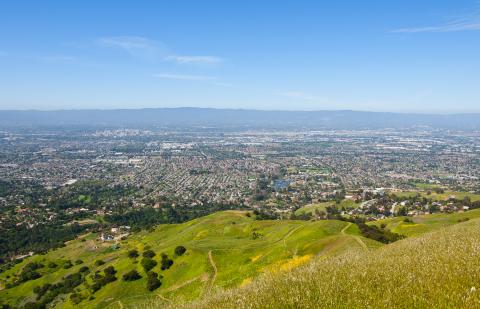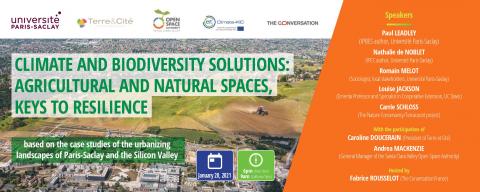
Online introductory webinar “Climate and biodiversity solutions: Agricultural and natural spaces, keys to resilience”
Université Paris-Saclay, Terre & Cité (T&C), the Santa Clara Valley Open Space Authority, the Nature Conservancy (TNC), the EIT Climate-KIC and The Conversation France are organizing an introductory webinar on Thursday, January 28, 2021 at 9am (California Time)/6pm (Paris Time) for students, researchers, academics, professionals and all those who are interested in deepening their understanding of the resilience and sustainability of peri-urban agricultural and natural spaces.
This introductory webinar will launch a series of short seminars to understand how the conservation of agricultural and natural peri-urban spaces can contribute to sustainable management and socioecological resilience, and clarify the role that research can play in this regard.
Recognized experts from California and France will present the key concepts and their applied research. Featuring local stakeholders, the webinar’s objective is to reflect on public policy design and its implementation in the field.
Who are the key actors who will enable the resilience of peri-urban spaces? What cooperation is needed to address global environmental issues at the local level?
If you are interested in this introductory webinar, our experts will be happy to share their expertise with you: Paul Leadley, IPBES author (Université Paris-Saclay), Nathalie de Noblet, IPCC author and CNRS researcher at the Laboratory for Sciences of Climate and Environment (UVSQ, CEA, CNRS), Romain Melot, Sociologist, local stakeholders (Université Paris-Saclay), Louise Jackson, Emerita Professor and Specialist in Cooperative Extension (UC Davis), Caroline Doucerain, President of Terre & Cité, Andrea Mackenzie, General Manager of the Santa Clara Valley Open Space Authority, and Carrie Schloss from The Nature Conservancy/Terracount project. The webinar will be hosted by Fabrice Rousselot (The Conversation France).

Understanding the concept of resilience for natural spaces
Marie Jussaume, a PhD student at the joint research unit UMR Géographie-Cités at Université Paris 1 Panthéon Sorbonne, explains the concept of resilience. "The term resilience was first used by materials physics and psychology experts to define an organism’s capacity to recover or regenerate. Since the 2000s, the term has also been used in ecology to describe a population or ecosystem’s ability to recover following a disturbance, by absorbing and correcting its effects. While the concept is widely used today, it is somewhat a source of debate. Unlike resistance, resilience attempts to reduce the impact of disturbances. But its application in local areas raises the question of its operational capabilities and how it can be translated into concrete solutions in areas with varying degrees of vulnerability.”
In Santa Clara and the Plateau de Saclay, "the increase in urban sprawl has led to the mass consumption of natural, agricultural and forest areas, which in turn has led to a decline in agricultural and forest edges". It is therefore essential that real solutions are discussed and planned, in order to limit damage, conserve natural spaces and protect biodiversity.
About the Plateau de Saclay and the Santa Clara Valley
The Plateau de Saclay extends across the urban communities of Paris-Saclay, Saint-Quentin en Yvelines and Versailles Grand Parc, and of which 10,168 acres (4,115 ha) are classified as an Agricultural and Forest Natural Protected Area (ZPNAF). Agricultural activity in the area is predominantly focused on conventional large-scale cereal farming.1
Established by an official government decree in December 2013, the Agricultural and Forest Natural Protection area (ZPNAF) is a protected area within the Plateau de Saclay, with a total surface area of 10,168 acres (4,115 ha), of which 6,101 acres (2,469 ha) are devoted to farming. The ZPNAF aims to develop dynamic and diversified agriculture throughout the area and conserve natural areas and landscapes.
The county of Santa Clara is one of the fastest growing counties in the state of California, putting considerable pressure on the region’s farmlands. Over the last 20 years, the county's farmland has decreased by 45% and fertile land remains threatened by urban development.2 Of the remaining 27,000 acres (10,926 ha) of farmland, approximately half is considered to be at risk of development in the next 30 years.3
In Santa Clara County, more than 132,000 people currently live in flood-prone areas.4 By 2035, water demand will have exceeded available water resources5 and temperatures will have risen by 3-10 degrees by 2050.
To combat the degradation of natural spaces and biodiversity, the Santa Clara Valley Open Space Authority is committed to several issues, including water quality, biodiversity conservation, agriculture, and farmland preservation.
About Terre & Cité
In 2001, farmers from the Plateau de Saclay came together to create the association Terre & Cité in an attempt to preserve the area’s farmlands. Today, Terre & Cité coordinates a local action group which receives European funding (LEADER program) to support agricultural projects, alongside a researchaction Living Lab approach that unites researchers, local stakeholders and farmers. How can we develop the resilience of the regions of the Plateau de Saclay and the Santa Clara Valley?
Don't miss this first introductory webinar and come and ask our experts your questions!
1 Source: Communauté d’Agglomération Paris-Saclay
2 Source: the California Farmland Conservancy website, 2014
3 Source: Greenbelt Alliance, 2012
4 Source: FloodSAFE California, 2013
5 cf. SPUR, 2013
